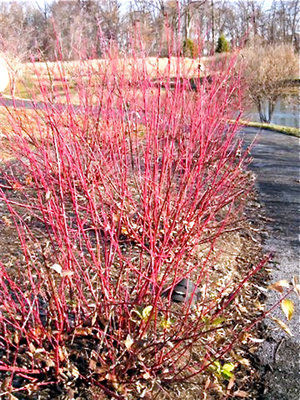
The flowering trees and shrubs of tropical Maui are behind me, and I’m back in our temperate rain forest of redwood trees and all things green. Sure, a few early blooming shrubs are flowering this time of year and are a welcome sight, but I look for color in other places. If you’re looking around your garden now and see mostly green, here are a few suggestions to brighten things up.
Native to moist places from Northern California to Alaska, the redtwig dogwood is stunning in the fall with its brilliant red foliage. In the winter, dark red stems provide a nice contrast to evergreen plants. This multi-stemmed shrub grows rapidly to between 7 and 9 feet high and spreads to 12 feet or wider by creeping underground stems and rooting branches, making it good for holding banks. Small fruits that attract birds follow 2-inch clusters of creamy, white flowers in the summer.
Looking for a plant that’s deer-resistant, beautiful and has edible stems, too? Plant a few cherry rhubarbs among your other perennials in a sunny or partially shady spot. The leafstalks have a delicious tart flavor and are typically used like fruit in sauces or pies. The leaves are poisonous, however, which is why deer avoid them.
If a tree has showy bark in winter, it earns its keep in the garden. The marina strawberry tree has rich, reddish-brown shredding bark on branches that tends to become twisted and gnarled with age. This evergreen tree is also pretty in the fall and winter, when rosy pink flowers appear at the same time as its strawberry-like fruit. It’s a good garden substitute for its relative, the native madrone, and performs well in a wide range of climates and soils.
I also like my coral bark Japanese maple in winter for its striking red twigs and branches. Upright and vigorously growing, it fits into narrow spots. I really like the bright-yellow fall foliage, too.
While you’re out in the garden between rain storms
• Revitalize overgrown or leggy hedges by cutting back plants just before the flush of new spring growth.
• Fight slugs and snails now with an iron phosphate bait, such as Sluggo, before they start feeding on your young seedlings and new transplants.
• Spray for peach leaf curl one last time before buds begin to open. Do not spray within 36 hours before rain is predicted.
• Begin sowing seeds of cool-season vegetables outdoors. If it’s been raining heavily, allow the ground to dry out for several days before working the soil. Plant seeds of beets, carrots, chard, lettuce, peas, spinach, arugula, chives kale and parsley directly in the ground. Later in the month, start broccoli, cabbage and cauliflower. Indoors, start seeds of tomatoes, peppers and eggplant so they will be ready to transplant outdoors in eight weeks.
• Jan Nelson, a California certified nursery professional at Plant Works in Ben Lomond, will answer questions about gardening in the Santa Cruz Mountains. E-mail her at ja******@*ol.com.












